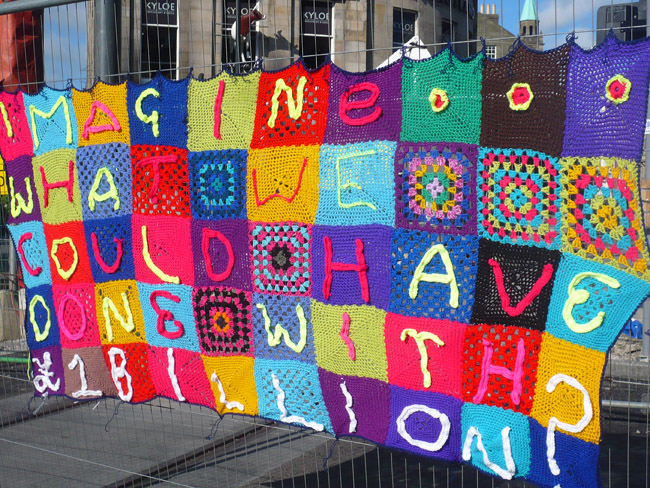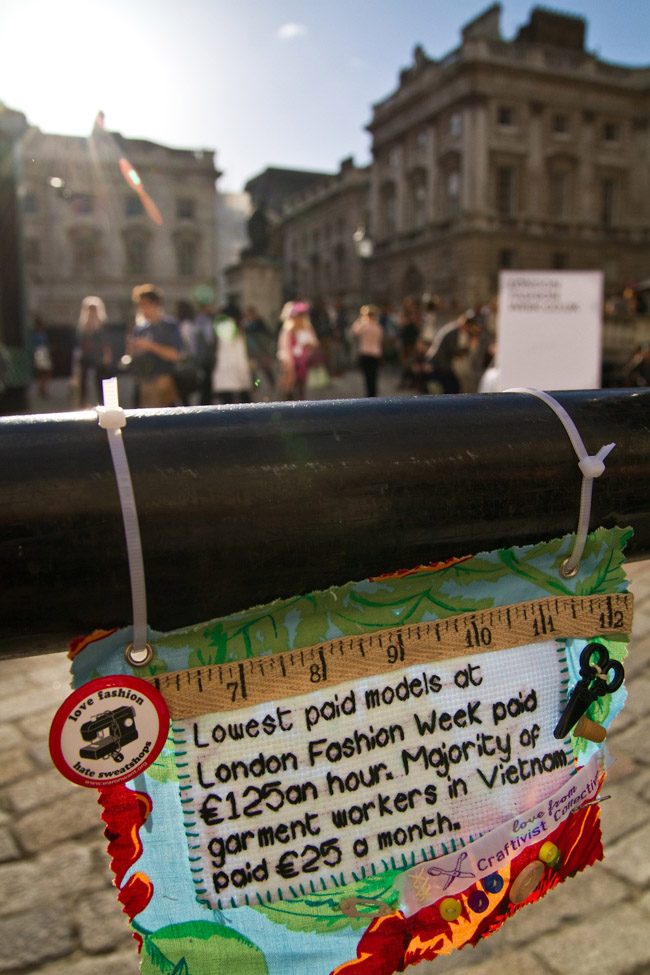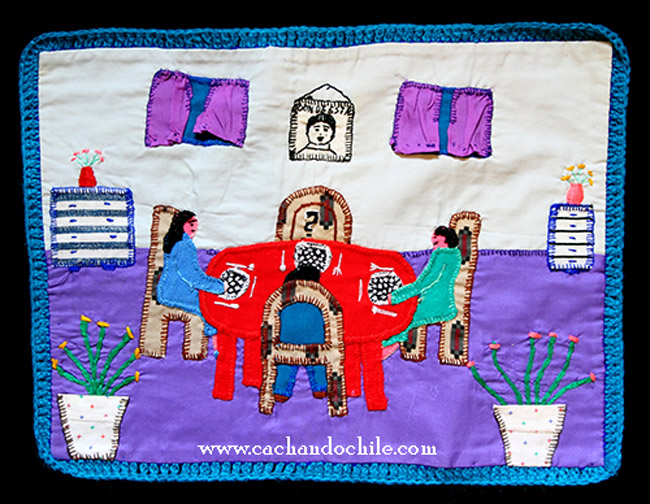Wide Angle Craft & Fashion: Craftivism

Sometimes I feel guilty that I’m not doing more to make the world a better place.
I’m not a doctor or a fire fighter. I blog and I like making pretty clothes. But recently I’ve discovered that craft and fashion have their own activist movements, and they’re doing great things!
“Wide Angle” is a 3 part series I wrote to share what I’ve learned with you. I hope you enjoy it!
Craftivism
I’ve often wondered how to channel my feelings on overwhelming issues like global poverty and social injustice.
Big crowds of people yelling – or making me feel inferior for not being passionate enough – have scared me away from movements I connected with philosophically.
And then I learned about Craftivism! Craft+Activism=Craftivism.
This movement has been so influential that it was listed with the likes of Etsy, Readymade magazine and Project Runway on The American Craft Council’s 70 Years of Craft History Timeline.
What’s The Goal? To shed light on scandals of our modern age through thought provoking, public craft art installations.
I love this idea because it is both non-violent and empowering to the individual. You can create pieces on your own, or rally a group of crafters to join you on a particular issue.
Example: Showing solidarity with garment workers around the world in a #MiniFashionProtest of London Fashion Week.

While Betsy Greer coined the Craftivism term in 2003, it is not a new concept. There is a long and inspirational history of craft being used to expose injustices.
Example: In the 70s and 80s, Chilean women used arpilleras like the one below to encourage a transfer of power from the dictator, Pinochet, to a democratically elected president.

A question mark on an empty chair represents the absence of a loved one and the uncertainty of his whereabouts or return. A black and white picture on the wall represents the ¿Dónde Está? photos the relatives of the disappeared wore on their chests demanding to know “Where is he?” You can learn more about Chilean aprilleras here.
If you’d like more information, check out the following resources:
- Craftivism Blog: Betsy Greer keeps you updated on new craftivism ideas, events and photos.
- Craftivist Collective: View their Project List or purchase their Mini Protest Banner Kit.
- Social Media: Use #MiniFashionProtest to see what people are working on.
- Crafty Magazine: Has a great blog page dedicated to Craftivism happenings and ideas.

 Sign In
Sign In

Comments
Vanessa
September 27, 2013 #
thanks for the info!
Nina
September 27, 2013 #
UK readers might like to know there’ll be a craftivist presence at the Knitting & Stitching Show next month – I think they’ll be getting people to make mini protest banners like the one pictured.
For me one of the best ways to link a love of sewing/knitting with love for the world is to choose my materials really carefully – there’s plenty of organic, Fairtrade, and other sustainable fabrics and yarns out there, we just have to educate ourselves about the issues to make informed choices. If you can choose the least harmful option every time at least that’s a start…
Rachel
September 27, 2013 #
That is very true, Nina, I may have to research material options next.
Nina
September 27, 2013 #
I wrote a post all about better cotton fabrics recently: http://toftsnummulite.blogspot.co.uk/2013/09/conscious-crafting-some-sewing-links.html .It’s mostly meant for UK-based sewers. I plan to do one soon about other fibres.
Mary Pat Gunn
October 29, 2013 #
Please do that piece.
Lin
September 27, 2013 #
I recently read the book by Elizabeth Cline, “Overdressed, The Shockingly High Cost of Cheap Fashion.”
What an eye opener. Ditto the information out there about animal welfare (look up mulesing on Google).
Although it’s not possible to make the perfect choice when buying clothing or fabric we all need to stay informed and make the right choice when we can. And of course we’re all not cut out to be active activists. To paraphrase Rachel, “I’m just a shop owner that likes to make pretty clothes.” We *do* have power and the more informed we are the more we can practice what I call “passive activism” by buying products we know are fairly produced.
It took me a while to reconcile the all-or-nothing feelings of guilt. I had to realize that even if I wore, say, cheap shoes from Gap, that choosing Fair Trade organic cotton for my next sewing project was a valuable statement and a part of the growing movement to treat people, animals, and the environment fairly. My cheap shoes did not cancel out the organic fabric. It’s our continuing awareness and our small choices that can bring change about. And my next pair of shoes will be a conscious decision…
Lori Basson
September 27, 2013 #
There’s so much more to say… starting, just at one point, with how during the time of slavery quilts were used to direct people to the Underground Railroad.
Rachel
September 27, 2013 #
I did not know that, thanks for sharing!
Jacqui
September 27, 2013 #
I think there are a lot of us out there who identify philosophically with various social movements but feel uncomfortable with the way those opinions are voiced. I decided to attend UC Berkeley, in part, because I wanted to be involved in social activism — but after four years of being surrounded by (often one-sided) screaming, I found myself overwhelmed and pretty turned off by the Bay Area’s style of protest. So like Lin and Nina, I found a more personal, quiet way to enact change: through my buying and sewing choices.
However, I have a deep admiration for the people who’ve enacted change by being loud and in-your-face, and it does make me feel obligated do more to get the word out about fair trade and other ethical fashion choices (among the myriad of worthy social causes out there!). Thanks for the reminder that there are people out there who aren’t afraid to make noise!
Alice
September 27, 2013 #
If you find an arpillera, look on the back. Sometimes you’ll find a tiny pocket containing a message or the name of the disappeared person.
Rachel
September 27, 2013 #
Oh wow, I didn’t read about that. Thanks, Alice!
Betsy Greer
September 27, 2013 #
Thanks so much for the kind words and for spreading the craftivism love!
Rachel
September 27, 2013 #
You’re welcome, Betsy :D
Constance
September 27, 2013 #
For me, sewing is both selfish and political, an expression of a long-standing boycott of maquiladoras, sweatshops, globalization and the violence perpetuated against women and children employed in the developing world garment industry. Clothing should be a local product because clothing reflects locality — cotton is great for a hot, damp climate, but doesn’t work so great in a Colorado winter — but I literally can’t walk into a global supply chain department store and buy wool jersey leggings or a wool challis dress shirt. My choices are make it, freeze, or contribute to climate change by turning up a thermostat. Independent patterns support independent artists and the local(ish) businesses that print and assemble them. The few remaining textile mills in the US are among the last holdouts of fairly compensated labor that doesn’t require a graduate degree. Pretty, well-fitted clothing that works for me is actually just a side benefit.
It makes fabric buying harder, and I’m not perfect — I’m still buying patterns that are produced a thousand miles away — but between using every scrap of fabric and thereby generating little waste, and relying on the inherently lighter carbon footprint of mail/package delivery and knowing what effort goes into garment production, this is how I can protest an inherently broken system.
Leigh
September 27, 2013 #
I think that people being enthusiastic about their passions is a wonderful thing, however the whole craftivism movement seems to imply that something I do for my enjoyment “isn’t good enough” unless I am also donating the project, my money/supplies and very little free time to craft for others. It almost seems like some sort of weird coolness competition to do more craftivism than the next person and try to strong arm every other person to do it too. I guess I have felt a lot more arm-twisting and condescension than love.
As Jacqui noted, there are many ways to give to the community, and we all need to find our comfort zone and appreciate others contributions. Sometimes a check is plenty for me and it has become tiresome to keep defending why I am not in on the current craftivism project(s) of the moment and that I really DO give time and money to various causes. So perhaps a bit of tolerance among the craftivists is called for as well?
And since I’m being all wet-blanket – sorry! :) – here is some info on the quilt and the underground railroad. It is quite unlikely that quilts were used in this way – unlike now, quilts took a long time to make by hand and were valued highly. No one would just leave one out in the weather to be ruined just in case someone was walking by and saw it and needed a place to stay.
The following comes from here: http://freedomcenter.org/underground-railroad/history/myths
One of the most famous symbols of the Underground Railroad is the quilt. Supposedly used as an indicator of a safe place, it is claimed that quilts were hung from roofs, barns, and fences to signal to enslaved individuals the location was a station on the Underground Railroad. There are two pieces of evidence that allow many historians to question the validity of Underground Railroad quilts. The first being that no former enslaved individuals accounts mentioned these quilts in the Works Progress Administration Slave Narratives from the 1930s. Second, that quilts also were not mentioned in any 19th Century slave narratives. Had these quilts been utilized by those participating in the Underground Railroad, it is likely that they would have appeared in at least a few of these narratives. There is also no hard evidence of their existence; no quilt with proven Underground Railroad usage has been found. Still, these quilts remain one of the most famous symbols of the Underground Railroad.
Nina
September 27, 2013 #
Wow, sounds like you must have been really, really unlucky with the craftivists you encountered! In my experience they’re thoughtful people who enjoy non-activist crafting too and often they’re actually quite shy (that’s why they’re embroidering mini-banners rather than leading marches)… What I’ve seen of the movement has been very open-minded and tolerant, almost to a fault!
Rachel
September 27, 2013 #
It is all about finding what you are comfortable with. Thanks for providing some alternate source info on the underground railroad quilts, it would be an interesting subject to read about further.
Sylvie
September 27, 2013 #
A great crafty related organization to help those in need is Project Linus. Not quite Craftism, but a great idea for sewing or quilting clubs to have a blanket making event and donate to Project Linus. The organization collects hand made blankets and donates them anonymously to children in need. In the words of their website, “Blankets are collected locally and distributed to children in hospitals, shelters, social service agencies, or anywhere that a child might be in need of a big hug.” Pretty awesome! http://www.projectlinus.org/
Rachel
September 27, 2013 #
Another great way to channel your do-gooder energy and love of crafting, thanks!
Stephanie
September 27, 2013 #
Craftivism won’t save the world, but doing the best we can, when we can: maybe it would make the world less bad? Usually I’m the wet blanket here, but even if I don’t make another thing in my life, at least I will have tried to do the right thing right now. I’m not looking for an argument; I’m looking for a solution.
I am glad to see this conversation here. More!
Carolina
September 29, 2013 #
Thank you for share about this arpilleras. I’m Chilean living in the other Pole and have not idea about it.
Passementerie
November 5, 2013 #
My contribution, (besides the choices for charitable giving that we continually make), is that I am looking to the Thrift stores for donated clothing made of a textile that I can reuse. Some of the fibers, weaves, embellishments, buttons, etc. , are things that I would not have found otherwise. The HUNT is thrilling!